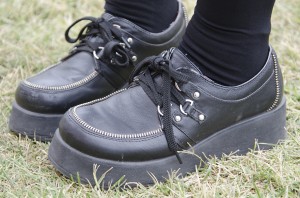It was the 1980s: Duran Duran was on the radio, MTV was still cool and monkey boots were all the rage.
Thirty years later, trends have changed and monkey boots, an ankle-length lace-up comparable to Doc Martens, have become just another forgotten shoe style of the past.
Along with the once-trendy monkey boots, the glam rock disco boots, the armadillo heel and the eternally hilarious Moon Shoes have gradually vanished from most wardrobes, with no certainty of regaining past popularity.
What connects these shoes besides their relatively short-lived demand is their ability to make their wearers stand out in a very identifiable piece of clothing. The shoes are recognizable and they make a statement.
Whether that statement is expressing a connection with certain past associations or marking shifts in current fashion styles, a message greater than shoes being worn purely for function is being communicated.
At the same time, the statement shoe can be very impractical, often being questionable in terms of price, comfort or aesthetics. Although these cons exist, it seems that the ever-changing trend of the statement shoe is still fairly present with students who choose to diverge from classic staple footwear such as Vans and Converse.
So are the shoes worth it?
Whenever I come across a student in a pair of platform jelly sandals, what first comes to mind is that the shoes are super cute. But when I think about them a little more, I wonder whether buying shoes with an uncertain fashion expiration date is the wisest decision. What’s stopping platform jelly sandals from becoming the next monkey boots?
Nothing is really stopping a trend from dying, yet on the other hand nothing is preventing the trend from miraculously resurfacing.

(Gabrielle Cabalza/Daily Bruin)
For instance, the Birkenstock, a chunky sandal made of a cork base with a thick leather or suede strap, can trace its origins to as early as the 18th century in a village in Germany and shoemaker Johann Adam Birkenstock.
The shoemaking tradition then passed down the family line, and what we know today as the Birkenstock came into being in the mid ’60’s, gaining popularity and eventually becoming associated with the granola hippie archetype.
The shoe has now almost completely shed its Vermont organic farmer vibe, being seen on various high-fashion runways in the past couple of seasons and evolving in form, coming in anything from neon to fur-lined styles.
“I think more people wear Birkenstocks now because they are cool and fashionable,” said second-year sociology student Alexandra Onea. “When I first got Birkenstocks they weren’t as popular, but I think they’ve always been a bit of a trend because they’ve been around for so many years.”
Creepers are another example of statement shoes whose origins derive from the past yet who have found a secure fashion niche in the present. Also known as brothel creepers, the shoe style features thick platform soles and resembles a mix between tennis shoes and men’s loafers.
The shoes’ style can be traced back to the footwear of soldiers fighting in the deserts of Africa during World War II. The shoes’ name refers to their functionality of allowing soldiers to creep around seedier evening spots.
From its military beginnings to later associations with music subcultures ranging from rockabilly to goth, creepers have once again resurfaced on the many fashion history-inclined, including students at UCLA.

Christina Mattson, a second-year undeclared student, said she first noticed creepers after seeing them being sold by street vendors in London two summers ago. She then looked them up on eBay and bought her first pair when she returned home.
“I think the shoes are a really easy way to add a tougher look to a more feminine outfit,” Mattson said. “That’s how I wear them, for example I’ll wear a floral dress with the giant shoes.”
While I believe the concerns about the impracticality of statement shoes to be valid, I cannot help but want to justify their place of value as a part of UCLA’s fashion scene past, present and future.
The statement shoe may be unpredictable in who will wear it, how long it will be in style and whether it could possibly come back in style, but I feel it is such uncertainty and constant evolution that makes fleeting trends special.
Without the cons of not always being the appropriate footwear choice for any and every occasion, the statement shoe would no longer be special and would no longer make any statement besides functionality.
“I think my creepers really tie an outfit together,” Mattson said. “I think that’s what I really like about a different kind of shoe – they can add a lot more to an outfit.”
So I guess the answer to the question I asked at the beginning of this column, as to whether buying a statement shoe was worth it, is yes. Not because these shoes are necessarily more practical, but because I realized that the shoes are more than just something you put on to cover your feet; they are a piece of clothing that can set you apart and add just a bit more to any outfit.
Do you think the statement shoe is worth buying?

As an alum of the University of California – Davis, my favorite shoe styles dating back to the late 1980’s-early 1990’s – ‘Gilligan-esque’ canvas sneakers with siped rubber outsoles and leather blucher moccasins – have always been reminiscent of the Northeastern United States and the Great Lakes – Upper Midwest. i simply wish that such shoe styles ought to be ubiquitous in major universities throughout the West Coast, especially California.